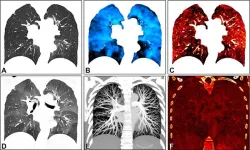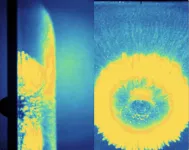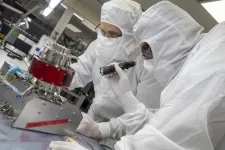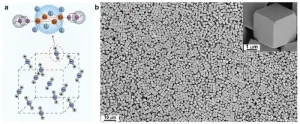A varied life boosts the brain’s functional networks
Results from a mouse study with novel biosensing technique
2023-07-11
(Press-News.org)
That experiences leave their trace in the connectivity of the brain has been known for a while, but a pioneering study by researchers at the German Center for Neurodegenerative Diseases (DZNE) and TUD Dresden University of Technology now shows how massive these effects really are. The findings in mice provide unprecedented insights into the complexity of large-scale neural networks and brain plasticity. Moreover, they could pave the way for new brain-inspired artificial intelligence methods. The results, based on an innovative “brain-on-chip” technology, are published in the scientific journal Biosensors and Bioelectronics.
The Dresden researchers explored the question of how an enriched experience affects the brain’s circuitry. For this, they deployed a so-called neurochip with more than 4,000 electrodes to detect the electrical activity of brain cells. This innovative platform enabled registering the “firing” of thousands of neurons simultaneously. The area examined – much smaller than the size of a human fingernail – covered an entire mouse hippocampus. This brain structure, shared by humans, plays a pivotal role in learning and memory, making it a prime target for the ravages of dementias like Alzheimer's disease. For their study, the scientists compared brain tissue from mice, which were raised differently. While one group of rodents grew up in standard cages, which did not offer any special stimuli, the others were housed in an “enriched environment” that included rearrangeable toys and maze-like plastic tubes.
“The results by far exceeded our expectations,” said Dr. Hayder Amin, lead scientist of the study. Amin, a neuroelectronics and nomputational neuroscience expert, heads a research group at DZNE. With his team, he developed the technology and analysis tools used in this study. “Simplified, one can say that the neurons of mice from the enriched environment were much more interconnected than those raised in standard housing. No matter which parameter we looked at, a richer experience literally boosted connections in the neuronal networks. These findings suggest that leading an active and varied life shapes the brain on whole new grounds.”
Unprecedented Insight into Brain Networks
Prof. Gerd Kempermann, who co-leads the study and has been working on the question of how physical and cognitive activity helps the brain to form resilience towards aging and neurodegenerative disease, attests: “All we knew in this area so far has either been taken from studies with single electrodes or imaging techniques like magnetic resonance imaging. The spatial and temporal resolution of these techniques is much coarser than our approach. Here we can literally see the circuitry at work down to the scale of single cells. We applied advanced computational tools to extract a huge amount of details about network dynamics in space and time from our recordings.”
“We have uncovered a wealth of data that illustrates the benefits of a brain shaped by rich experience. This paves the way to understand the role of plasticity and reserve formation in combating neurodegenerative diseases, especially with respect to novel preventive strategies,” Prof. Kempermann said, who, in addition to being a DZNE researcher, is also affiliated with the Center for Regenerative Therapies Dresden (CRTD) at TU Dresden. “Also, this will help provide insights into disease processes associated with neurodegeneration, such as dysfunctions of brain networks.”
Potential Regarding Brain-inspired Artificial Intelligence
“By unraveling how experiences shape the brain’s connectome and dynamics, we are not only pushing the boundaries of brain research,” states Dr. Amin. “Artificial intelligence is inspired by how the brain computes information. Thus, our tools and the insights they allow to generate could open the way for novel machine learning algorithms.”
--
About the Deutsches Zentrum für Neurodegenerative Erkrankungen, DZNE (German Center for Neurodegenerative Diseases): DZNE is a research institute funded by the German federal and state governments, comprising ten sites across Germany. It is dedicated to diseases of the brain and nervous system, such as Alzheimer’s, Parkinson’s, and ALS, which are associated with dementia, movement disorders and other serious health impairments. To date, there are no cures for these diseases, which represent an enormous burden for countless affected individuals, their families, and the healthcare system. The aim of DZNE is to develop novel strategies for prevention, diagnosis, care, as well as treatment, and to transfer them into practice. To this end, DZNE cooperates with universities, university hospitals, research centers and other institutions in Germany and abroad. The institute is a member of the Helmholtz Association and belongs to the German Centers for Health Research. www.dzne.de/en
About the Center for Regenerative Therapies Dresden (CRTD): The Center for Regenerative Therapies Dresden (CRTD) of TU Dresden is an academic home for scientists from more than 30 nations. Their mission is to discover the principles of cell and tissue regeneration and leverage this for the recognition, treatment, and reversal of diseases. The CRTD links the bench to the clinic, scientists to clinicians to pool expertise in stem cells, developmental biology, gene-editing, and regeneration towards innovative therapies for neurodegenerative diseases such as Alzheimer's and Parkinson's disease, hematological diseases such as leukemia, metabolic diseases such as diabetes, bone and retina diseases.
The CRTD was founded in 2006 as a research center of the German Research Foundation (DFG) and funded until 2018 as a DFG Research Center, as well as a Cluster of Excellence. Since 2019, the CRTD is funded by the TU Dresden and the Free State of Saxony.
The CRTD is one of three institutes of the central scientific facility Center for Molecular and Cellular Bioengineering (CMCB) of the TU Dresden.
www.tu-dresden.de/cmcb/crtd / www.tu-dresden.de/cmcb
END
ELSE PRESS RELEASES FROM THIS DATE:
2023-07-11
BINGHAMTON, N.Y. -- A strange mystic swings a pocket watch back and forth, repeating the phrase “You’re getting sleepy, very sleepy,” giving them absolute command over their subject. That’s not how hypnotism really works, but it’s the way it’s often depicted in pop culture. Even some clinicians and hypnosis educators propagate harmful myths about hypnosis.
Steven Jay Lynn, a professor of psychology at Binghamton University, State University of New York, is an expert on hypnosis who has made major contributions to the judicial system ...
2023-07-11
(WASHINGTON, July 11, 2023) – As the United States faces a growing obesity epidemic, scientists are taking a closer look at how body weight can affect health outcomes. New research published in Blood Advances highlights the potential association of elevated body mass index (BMI) with inferior outcomes to treatment for acute lymphoblastic leukemia (ALL) in adolescents and young adults (AYAs). This study sheds light on the impact of weight on treatment toxicities and outcomes and calls for further study of the impact of weight on response to different ALL chemotherapy regimens.
Obesity is a growing public health threat in the United States, affecting approximately ...
2023-07-11
OAK BROOK, Ill. – New CT technology allows for a comprehensive, simultaneous evaluation of lung structure and function, something not possible with standard CT, according to a study published in Radiology, a journal of the Radiological Society of North America (RSNA).
Chest CT is the imaging method of choice for analyzing lung disease and tracking changes over time. However, CT studies of lung function and perfusion, or blood flow, require dedicated protocols that cannot be combined.
Researchers in Germany and the Netherlands developed a chest imaging protocol that yields ...
2023-07-11
PHILADELPHIA – A $40.5 million grant from the National Institute on Aging (NIA), part of the National Institutes of Health (NIH), will fund the Asian Cohort for Alzheimer’s Disease (ACAD) study at Penn Medicine and 15 other academic research centers across the United States and Canada. Led by Li-San Wang, PhD, the Peter C. Nowell, M.D. Professor of Pathology and Laboratory Medicine in the Perelman School of Medicine at the University of Pennsylvania, the project represents the first major Alzheimer’s disease genetics cohort for Asian Americans and Asian Canadians, populations currently underrepresented in Alzheimer’s disease research. The other principal investigators ...
2023-07-11
Moral values such as purity and loyalty are often linked with hateful language, according to a study. Scholars in the field of Natural Language Processing (NLP) have in recent years focused on improving the automated detection of hate speech so such language can be removed from online spaces. But some scholars have argued that mere detection is not a real solution—that NLP can and should be used to investigate the roots of hateful language. Morteza Dehghani and colleagues conducted three studies of hateful language, looking at speeches and texts written by leaders of the Nazi party between 1933 and 1945, hateful slurs ...
2023-07-11
An experimental study explores the visible impact flash created by high velocity impacts. Impacts by debris and meteoroids pose a significant threat to satellites, space probes, and hypersonic craft. Such high-velocity impacts create a brief, intense burst of light, known as an impact flash, which contains information about both the target and the impactor. Gary Simpson, K.T. Ramesh, and colleagues explored the impact flash by shooting stainless steel spheres into an aluminum alloy plate, at a speed of three kilometers per second — about 6,700 miles per hour, or more than nine times the speed of sound. The resulting impact flashes were photographed ...
2023-07-11
SAN ANTONIO — July 11, 2023 —Southwest Research Institute has delivered a plasma spectrometer for integration into a lunar lander as part of NASA’s Lunar Vertex investigation, scheduled to commence next year. The target site is the Reiner Gamma region on the Moon’s nearside, a mysterious area known to have a local magnetic field. The SwRI-developed Magnetic Anomaly Plasma Spectrometer (MAPS) will study the interaction of the solar wind with surface materials on the Moon, aiming to understand the origin of the sinuous patterns of ...
2023-07-11
Scintillators are optical materials that emit low-energy ultraviolet and visible photons in response to ionizing radiation such as X-rays and gamma rays. This property makes scintillating materials useful for applications like non-destructive testing, X-ray astronomy, security inspection, and medical imaging.
In a recently published paper in Light Science & Applications, Professor Xiaowang Liu and Academician Wei Huang, along with their team from the Institute of Flexible Electronics at Northwestern Polytechnical University, ...
2023-07-11
DALLAS, July 11, 2023 — Two dedicated volunteers have reached a prestigious milestone with the American Heart Association, the world’s leading nonprofit organization devoted to a world of healthier lives for all, for their personal passion and commitment to advance women’s heart health.
For the third year, changemakers across the country were nominated to join the American Heart Association’s Woman of Impact and Teen of Impact® campaigns. Aligning with the Go Red for Women® movement, the Association’s signature ...
2023-07-11
The Xerces Blue butterfly (Glaucopsyche xerces) was native to the coastal dunes of San Francisco, in the United States. As the city grew, much of the butterfly’s habitat was destroyed and its population was relegated to Golden Gate National Park. Its wings were a deep iridescent blue, with characteristic white spots on the ventral side. The last surviving specimens of the species were found in 1941, by entomologist W. Harry Lange. It is considered the first insect species to have become extinct in historical times. Its disappearance has made it a global icon of anthropogenic extinction, to ...
LAST 30 PRESS RELEASES:
[Press-News.org] A varied life boosts the brain’s functional networks
Results from a mouse study with novel biosensing technique




